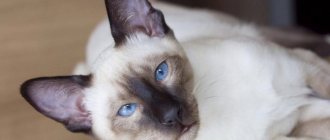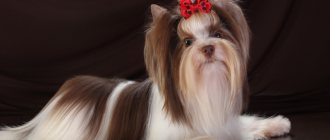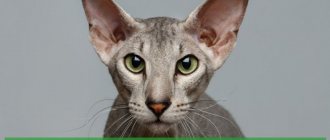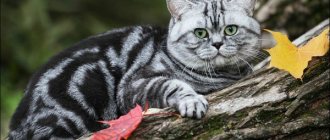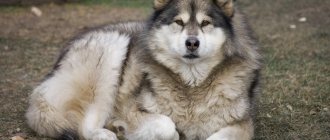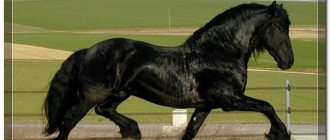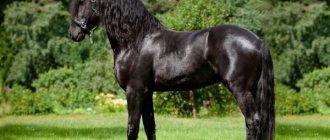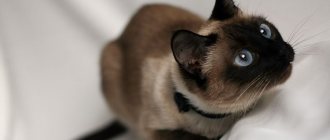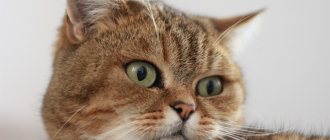Cats with big ears delight the eye with their appearance. Huge ears add elegance to the silhouette, a certain grace and tenderness. Due to their original appearance, cat breeds with large ears have a huge number of fans around the world. And some new breeds of eared cats are record holders for the cost of a kitten.
There are now a huge number of cat breeds that have larger than average ears:
- abyssinian cats,
- Balinese cats or Balinese cats,
- Devon Rex and Gherkin Rex,
- Canadian, Don Sphynxes, as well as Peterbalds,
- kanaani,
- Maine Coon,
- orientals,
- savannas,
- Serengeti,
- Somali or Abyssinian longhaired cats,
- Ukrainian Levkoi,
- elves
Abyssinian cats
It is representatives of this breed that are depicted on the walls of Egyptian pyramids and temples. The Abyssinian cat was worshiped not only in Egypt, but also in Mesopotamia.
Expert opinion
Danilova Maria Alekseevna
Therapist, dentist, ophthalmologist, surgeon, express tests, ratologist, groomer.
Cats of this breed are very sociable, curious, and do not tolerate loneliness well. They prefer active games and a high point of observation of household members.
It is optimal to provide them with the opportunity to climb and jump - mobility is the key to the health of this breed. Abyssinians have a high life expectancy: 15-20 years.
Somalia
The “heir” of the Abyssinian cat, unexpectedly “dressed up in a luxurious fur coat” in red-brown tones. Why the Abyssinians got semi-long hair is unknown; geneticists are inclined to the version of a natural mutation. Active and tireless, like their ancestors, Somalia, boasts large and mobile ears.
Read more about the Somali breed
Balinese
The Balinese cat is a direct descendant of the Siamese cat, but did not inherit from the latter a tendency towards aggressive behavior, vindictiveness and capriciousness. The Balinese also differs from the Siamese in the type of coat: it is soft, long and without undercoat.
Cats of this breed are quite intelligent and very attached to their owner. Often such affection is a burden, since the pet will follow relentlessly on your heels. But the Balinese are quite capricious at the same time: they will not do what they do not like, and will achieve what they want by any means.
Description of breeds
Abyssinian
10,000 - 45,000 rub.
Australian smoke
Asian smoky cat
Asian tabby
Alaskan snow cat
American Wirehair cat
American Keuda
American Shorthair
from 400 USD
American Bobtail
American Curl KSH
American Curl
from 500 USD up to 4000 USD
Anatolian cat
Balinese
Bengal cat
from 800 to 2000 euros
Bohemian rex
about 1000 USD
Bombay
Brazilian Shorthair
10-15 thousand rubles
British Longhair
from 500 to 1500 USD
British Shorthair
from 500 to 1500 USD
Burmanskaya
from 600 to 1500 USD
Burmilla
from 500 US dollars
Viverrid fishing cat
Havana Brown
individually
Herman rex
Himalayan
300-1300 USD
Devon rex
from 400 to 1500 USD
Jungala
Don Sphynx
from 100 to 800 ye
European Shorthair
Egyptian Mau
1000-3000+ euros
York chocolate
California radiant
Kanaani
Canadian Sphynx
from 400 to 1500 dollars
Karelian Bobtail
from 1000$
Cymric
Korat
Cornish Rex
from 300 to 1000 USD
Kurilian Bobtail
from 300 to 1200 USD
La Perm
1000-1600 dollars
Munchkin
10000-25000 rubles
Maine Coon
from 500 to 650 euros
Mekong Bobtail
from 200 to 700 USD
Manx
Neva Masquerade
from 200 to 700 USD
Nibelung
Norwegian forest
15-17 thousand rubles.
Oriental Shorthair
from 300 to 1300 USD
Oriental semi-longhair
Ojos Azules
Cats are usually more expensive than cats.
Ocicat
Persian
from 50 to 1000 USD
Petersburg Sphinx
300 USD — 1300 USD
Pixie Bob
Russian blue
from 200 to 800 USD
Ragdoll
Savannah
from 4,000 dollars
Safari
7-10 thousand conventional units
Sacred Burma
Selkirk rex
15-20 thousand rubles
Siamese
from 200 to 1200 USD
Siberian
from 200 to 800 USD
Singaporean
From 700 to 4000 USD
Snow-shoe
Somalia
300-1800 dollars
Soukok
Thai
from 5000 to 9000 rubles
Toyger
from 100 to 200 thousand rubles
Tonkinese
from 5 to 25 thousand rubles
Turkish Angora
from 150 to 500 USD
Turkish van
Ukrainian Levkoy
from 15,000 to 20,000 rubles
Ural rex
from 15 to 50 thousand rubles
Highland fold
from 6,000 to 25,000 thousand rubles.
Ceylon
Chartreuse
from 300 to 600 dollars
Chauzie
Scottish lop-eared
from $100 to $1000
Exotic Shorthair
from 300 to 1000 USD
Javanese
Devon Rex and Gherkin Rex
The Devon Rex breed, bred in England, quickly conquered the world. The cats have a nice short, slightly curled coat, with huge ears sometimes topped with tufts.
Expert opinion
Slanimsky Alexey Georgievich
Veterinarian of the highest qualification category. Has extensive experience in diagnosing and treating diseases in animals.
You are unlikely to find a more loyal cat than the Devon Rex. Cats of this breed are very smart, easily learn commands, and cases have been recorded of Devon Rex protecting their owners.
In their behavior, Devons and Cornishes are the epitome of aristocracy: they do not steal food from the table, they are instantly litter-trained, they are as clean as possible, they are not vengeful and do not bite. They can be easily walked on a leash and experience virtually no stress when traveling or moving.
Poodlecat
The Pudelcat breed was created not so long ago. The cats have soft, curly fur and resemble a poodle in appearance. Representatives can have straight ears (straight), and there are also fold ears.
Since the Pudelcat breed appeared not so long ago, it has not yet become so popular, many people still do not know about it. Cats and cats have an easy-going and friendly character; they quickly adapt to home conditions and tolerate loneliness.
Important! A distinctive feature of the Pudelcat breed is the presence of fine curls of hair. Their ears are usually long and slightly drooping. The muzzle is small, short, with large round eyes located on it.
Maine Coons
The origin of this cat is surrounded by myths: they claim that the breed was obtained by crossing a cat and a lynx. But that's not true. Initially, the breed was very common in Maine. Severe snowy winters have led to the appearance of cats with thick, long hair, large paws and tufted ears.
The Maine Coon breed gets along well with people, but is not overly tame. They are moderately sociable, calm, and in their youth they prefer to climb trees. Coons inherited a passion for hunting from their ancestors, and kittens of this breed love to play with balls and toy mice.\
Rare and non-standard cat breeds
Poodlecat - curly beauty
Both varieties of poodle cats - with erect and hanging ears - deserve attention in this article. However, breeders strongly recommend breeding representatives with erect ears to avoid skeletal problems. Poodlecats stand out not only for their large ears, but also for their unusually curly coat that does not require special care. They have a very kind and affectionate character and get along well with adults, children and other pets. They do not tolerate loneliness well.
Havana cat
One of the oldest specially bred cat breeds almost disappeared completely during the Second World War, but in the 50s of the last century they began to be specially bred in Britain, and then registered in 1958. Havana cats will spend all their time with you or other pets; they are one of the most sociable breeds. And therefore, from loneliness, they easily become depressed and get sick. They are distinguished by their intelligence and intelligence, are easy to educate and train, and will never use their claws and teeth without a good reason.
Toyger - domestic mini-tiger
Of course, when these cats are called tigers, they mean striped color.
The weight of the cat itself can reach up to 9-11 kilograms, which is slightly more than average. The character differs little from ordinary cats; they are docile and unobtrusive. Toygers are big fans of sharpening their claws, so it is important to teach the kitten to do this with a scratching post.
Absolutely all individuals of this cat breed are controlled by the parent nursery of Judy Sugden and selection to improve this breed is currently ongoing.
Source
Savannah
The breed was obtained by crossing a Serval and a Siamese cat and was registered only in 1996.
Representatives of the breed are distinguished by great intelligence and intelligence, they are easy to train and are able to remember several commands. The character is very playful and sociable, the cat does not tolerate loneliness. The Savannah has a long maturation period; it will take about three years for the character to be fully formed.
Useful video
All about the domestic serval:
Hybrid big-eared cats
Hybrid breeds are those obtained by crossing wild cats with domestic ones. Among these representatives of the cat family there are many specimens with large ears:
- The Savannah, obtained from the union of the Serval and the Abyssinian cat, is distinguished by the largest size among its kind. Purchasing and maintaining such elite pets, similar in appearance to Servals, will not be cheap.
- By crossing the Abyssinian with a jungle cat, the breeders got Shauzi, whose appearance resembles a Caracal. These beauties, who have inherited the hunting instincts of their wild ancestor, are recommended to be kept in a spacious enclosure. The color of the animal can be black or ticked (silver, sorrel).
- The Caracat hybrid, which inherited the genetic material from the Abyssinian and the steppe Caracal, is only slightly different in appearance from its wild ancestor. Caracats have an even temperament, curiosity and large size. The tips of the pet's ears are decorated with black tassels.
Serengeti
A new and still expensive cat breed was officially registered only in 1994, but does not yet have the status to participate in exhibitions. Despite the fact that the name is similar to the wild serval, the breed was obtained by crossing a spotted oriental cat with a Bengal cat.
The cat's vocabulary is incredibly rich - she will follow the owner's heels and purr, sing, and click. It is worth considering the increased activity and some aggressiveness of the breed. They need to hunt and will do this by attacking their legs and arms. They are very active, stubborn and demanding.
Kanaani
This breed is experimental, obtained by crossing a domestic cat with a wild Libyan cat. The homeland of the Kanaani is Israel, where this breed is considered the heritage of the country. The breed received official international recognition in 2009. However, Kanaani kittens can only be purchased in Israel and Germany. This breed is not found anywhere else.
Kanaani is a fairly large, muscular cat with short, coarse hair. A characteristic feature of the breed: the hind legs are much longer than the front . The Kananny is very similar to the Oriental cat, so they are often confused.
Sphinxes: Canadian, Don and St. Petersburg
The most controversial cat breed is the Sphynx. Bald, with large ears, and an abundance of folds of skin, they evoke either boundless love or the same boundless disgust. The first representatives of the breed were obtained in the mid-20th century in Canada. Now there are three lines: Canadian, Don and St. Petersburg.
Sphynxes seem to be an incredibly loving breed: they will prefer to sit in their owner's arms and sleep with them. But don’t be fooled – it’s just cool for them in our apartments.
Elf
A young breed descended from the crossing of American Curls and Canadian Sphynxes. The elf has the distinctive features of both parents - hairlessness and folded back ears. However, unlike the American Curl, Elves have impressively sized ears. The cat has a very friendly character and canine loyalty.
More about the Elf breed
Features of cats with big ears: myths and reality
- MYTH 1. There is a common misconception that a cat's large ears somehow affect the acuity of its hearing. The animal hears better and therefore representatives of some breeds can potentially be better mouse hunters.
The size of the ears does not affect the cat’s hearing in any way: it is no worse and no sharper than that of representatives of other breeds.
- MYTH 2. Cats with big ears are unsociable and independent.
This is wrong. The character of a cat depends on both the breed and the personality characteristics of the animal. Some representatives of large-eared breeds are indeed not very sociable and extremely independent, but Abyssinian cats, Ukrainian Levkoys and Maine Coons have a very positive attitude towards people, despite their impressive size and menacing appearance.
- MYTH 3. Big ears are the result of a mutation; such cats are not entirely healthy.
No, large ears are characteristic of those cat breeds whose representatives inhabited hot Africa and Asia. It was precisely because of high temperatures and increased requirements for thermoregulation that natural selection left the most large-eared representatives of the feline genus.
Only a small part of cat breeds with large ears were bred by breeders specifically for decorative purposes. Representatives of such breeds may have some health characteristics.
- REALITY. A cat's large ears allow it to cool itself more efficiently and quickly.
The ears contain a huge number of blood vessels. When the kotofey overheats, the blood cools through numerous capillaries that approach the surface, including in the area of the ears.
- REALITY. Big-eared cats are freezing.
Yes, most breeds of large-eared cats have either very short hair or are completely bald, and therefore are picky about room temperature. The exceptions are Maine Coons, Savannahs and Serengeti. These dogs have a dense undercoat that allows them to feel comfortable even in cold weather.
Ukrainian Levkoy
The breed originated from crossing the Don Sphynx and Scottish Fold cats. The result was a hairless cat with an oriental body type, a slightly rounded muzzle and large, round, curved ears. The breed was named after the flower that resembles the folded ears of the Ukrainian Levkoy.
More information about the Ukrainian Levkoy breed
Keeping eared cats
Ugly cat: examples of the ugliest breeds
A purebred eared cat requires attention no more and no less than a cat with small ears. Regardless of the size of the hearing organs, pets need care and communication with the owner. However, it is cats with long ears that require special attention when it comes to caring for their ears.
Ear cleaning should be done every 2 weeks
Ears should be cleaned regularly to prevent them from:
- otitis;
- tick infestation;
- excessive selection of sebaceous glands;
- allergic reactions;
- diseases caused by natural pollution.
A cat with large ears does not need daily ear cleaning. An inspection once every 1-2 weeks will be sufficient. The exceptions are fold-eared cat breeds and sphinxes. They require inspection somewhat more often.
Note! Cats' diet should be balanced. If the diet is not of sufficient quality, pets may develop various diseases, including ear diseases.
Owners love their pets not for their appearance. Regardless of whether a cat with a big nose lives in the house or he has big ears, he will be loved for his character. If a person is just thinking about getting a kitten, he should definitely pay attention to big-eared cats, as they are incredibly smart and quick-witted, and their beautiful appearance will delight the eyes of experts at the exhibition. Those who have already got a cat with big ears should not forget that they require special care.
